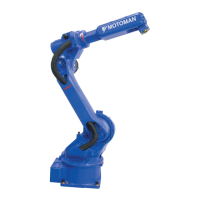3 Developing with MLX200
3.3 Programming Introduction
3-11
168542-1CD
168542-1CD
MLX200 Software and
Operations
The same structure can also be used to execute configuration instructions
such as setting base poses or interference zones.
3.3.4 Motion Instructions
The MLX200 motion instructions will make up the bulk of most
applications. One simple way to use the motion instructions is to treat
every rung of ladder as a “step” and then move to the next step when the
motions have finished executing (i.e. the Sts_PC bit turns on). An example
of this is shown in Fig.3-11 "Example Ladder Rung of Simple Motion". The
rung-in condition here checks whether the variable “step” is 10 and then
calls an MLxRobotMoveAbsolute with the control variable “moveHome[0]”
when this condition is true. Then, it waits for the moveHome [0].Sts_PC to
turn on and moves to the next step of the ladder.
Fig. 3-11: Example Ladder Rung of Simple Motion
• Configuration instructions that affect program behavior
(such as base pose, tool pose, interference zone, etc)
should be executed during application initialization as
these values will not hold over when the MLX200 Robot
Control Module is restarted.
• Every MLX200 instruction takes an MLxData parameter.
By default, this parameter should always be MLX[0]. If
using multiple MLX200 Control Modules, this parameter
is used to send the command to the proper MLX200
Control Module.
It is often useful to define the control variables as arrays for
motion instructions that will be used often in the program.
This will cut down on the number of program variables and
make the program easier to read.

